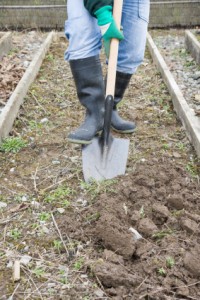 Even though there is frost in the air, and possibly snow on the ground, now is the time to prepare for next year’s harvest. Though not much grows when the ground is cold and the air is frozen, the beds or fields need tending to make them ready to be planted. This article is for the beginner as well as the person who has been gardening for years.
Even though there is frost in the air, and possibly snow on the ground, now is the time to prepare for next year’s harvest. Though not much grows when the ground is cold and the air is frozen, the beds or fields need tending to make them ready to be planted. This article is for the beginner as well as the person who has been gardening for years.
Preparation
The first thing is to decide what type of gardening will work best for you. If you are blessed with acreage for your gardening project, then row planting will be the format for your fields. When you plow your fields, you should plow in such a way that the rows run opposite of the main direction that your wind blows, as this will help keep the topsoil from blowing away.
If you live in urban areas or close-quartered rural areas, then a portion of your yard may be the area you have available. You may still want to garden in the traditional rows, or try square foot or another type of raised bed gardening. Once you have decided on the type of garden you want to grow and the place for your garden, you will start preparing your tools and beds.
Gathering your tools
Working in your garden requires several basic tools: these include a good pair of gloves, a shovel, a rake, a hoe, a garden trowel, a claw cultivator, and at least one five-gallon bucket. I like having two or three buckets handy, along with their lids, if possible. I use one in which to store my smaller tools for ease in locating and carrying around the yard. These tools should be stored in a handy location close to your garden area. When you have gathered and placed these tools in their place, take a few minutes to inspect them to see if they are in good condition. Sharpen the edge of your hoe and shovel, clear any rust from your tools, and tape up any rough or splitting wooden handles.
Preparing your beds
While the ground is lying dead and partially frozen, you should go out into your fields and decide which area you will allow to lie fallow this season. God said in Exodus 23:10-11 KJV; “And six years thou shalt sow thy land, and shalt gather in the fruits thereof: but the seventh year thou shalt let it rest and lie still; that the poor of thy people may eat: and what they leave the beasts of the field shall eat. In like manner thou shalt deal with thy vineyard, and with thy oliveyard …” God contrasts the practice of leaving ground to lie fallow to His children whom He had told to rest one day in seven. He knew that the land needed to be refreshed after growing crops for six years. Vitamins needed to be replenished and vitality added to it once again.
On the fallow ground put a good deep layer of fresh cow manure – hay and all, right from the pastures and milking stall. It should be about six inches to eight inches deep. Local farmers may let you have all you need just for hauling it off.
In small gardens leaving a portion fallow may not work, but we will discuss later how to give your garden the nutrients needed so that it can be used yearly and still yield the most fruits/vegetables possible.
In the fields or beds to be planted, you cover the ground with cow manure to 3 inches deep and till it under. Leave it thus until all threat of frost has passed, then plow it and plant as you wish. Large areas can be plowed with machines and smaller areas can be done with a shovel and/or hoe. In the areas to be planted this spring you may want to use composted manure. This is manure that has been setting in heaps, stirred and watered weekly to allow it to break down into rich, black dirt. If you live in a dry area, such as I do in northwestern Nevada, it is helpful to water your garden once a week to help your fertilizer break down and leach the nutrients into your ground.
Cow manure and horse manure are relatively mild and can be used in the amounts that I have mentioned. Chicken manure can also be used, but needs to be used in smaller amounts as it is much hotter. Mix it down by adding 1 part chicken manure to 3 parts of soil before adding to your garden. I raise rabbits so I use rabbit manure in my garden in the same manner as horse and cow manure, but only about one or two inches deep. Later in the growing season, I feed the garden with a “Rabbit Tea.” I place about four inches in the bottom of a five-gallon bucket and fill it with water. I let this sit for a few days before I start using it, allowing the droppings to break down and emulsify into the water. Stir well and pour about a quart at the base of your plants, then water as usual. I feed them weekly, more often if they look like they need it.
Now we know that winter is gardening time! Get ready. Get set. Let’s Grow!
 Off The Grid News Better Ideas For Off The Grid Living
Off The Grid News Better Ideas For Off The Grid Living



